Here’s What We Learned From 50 of the Most Popular Blogs
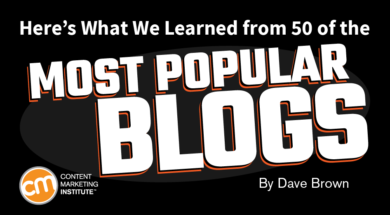 Blogging has come a long way from the days of niche link catalogs and online journals. From the stratospheric rise of content aggregators such as Huffington Post and Gizmodo in the late 2000s to popular figures such as Tim Ferriss, Michelle Gardner, and Amber Clark, a slew of digital superstars emerged over the years.
Blogging has come a long way from the days of niche link catalogs and online journals. From the stratospheric rise of content aggregators such as Huffington Post and Gizmodo in the late 2000s to popular figures such as Tim Ferriss, Michelle Gardner, and Amber Clark, a slew of digital superstars emerged over the years.
But creating real engagement through written content alone is tougher today than ever before. Recent estimates place the number of new blog posts published every day at over 4 million.
Adding to this, Google and other search engines implement increasingly inscrutable algorithms that rank web content on everything from mobile friendliness to video integration, page structure, and constantly shifting keyword optimization guidelines.
Finally, the staggering growth of social media has pushed many bloggers (especially in lifestyle and fashion verticals) to branch out with their brands into platforms like Instagram, Twitter, and Facebook to attract more organic buzz around their long-form content.
Today, even the most casual hobbyist keeps an eagle eye on metrics involving page traffic, shares, and bounce rates, while readers demand relevant and personalized content with every click. In this cutthroat environment, enthusiasm and proficiency aren’t enough to generate traffic.
In cutthroat blog environment, enthusiasm and proficiency aren’t enough to generate traffic, says @DaveBrown500.CLICK TO TWEETWith these competitive forces at play, bloggers must work twice as hard to draw consistent and relevant traffic to their chosen platforms.
Blueprint for blogging success
Despite the challenges, brands and individuals have managed to engineer considerable success through carefully planned content strategies that owe just as much to data analytics, SEO, and UX as the desire for creative expression.
From entrepreneurs and sports enthusiasts to thought leaders, stay-at-home moms, and digital marketers – innovators in every space have leveraged their blogs to attract increasingly skeptical audiences.
To find out exactly what separates the cream of the crop from also-rans, we took a deep dive into each of these blogs to find out what really makes them tick.
Our research is based on a list of 50 websites chosen for the quality and volume of traffic as well as their overall popularity across social media and search engines.
Research data was sourced from Alexa’s website rankings across several categories including sports, media, news, and lifestyle blogs. We combined these raw statistics on bounce rate, page views, and stickiness with our benchmarks to determine which websites had domain authority to qualify for this list.
The featured blogs in this article were chosen because they exemplify a relevant best-practices approach to design and content writing or they do something significantly different from the rest of the pack. Here’s a rundown of our findings.
Design for the scroll
Getting visitors to your blog is great, but unless they stick around to read the content the benefits are limited. Unfortunately, in a world where the average person judges a site within a tenth of a second, creating stickiness is easier said than done, which explains why bloggers spend so much time poring over their bounce rates.
One of the biggest barriers to visitor retention is poor navigation. If first-time readers have to spend more than a few seconds to find the content they need, they’re far more likely to opt for a more intuitive alternative.
One of the biggest barriers to visitor retention is poor navigation, says @DaveBrown500.CLICK TO TWEETThis factor becomes even more critical when you consider the fact that an estimated 1 million users engage with blog posts through their smartphones every day. The process of finding and clicking on a link through a compressed mobile display can be understandingly frustrating. If you want to optimize your content for these audiences, ensure that they can scroll to the information they want as easily as possible.
One platform that has managed to embrace this concept to the fullest is TMZ. Upon entering the website, you’ll find that the main body of content is within a narrow 708-by-646 pixel region, an optimized range which provides maximum readability for large chunks of text.
.@TMZ site optimizes for scroll – narrow content body + recent posts displayed on right, says @DaveBrown500.CLICK TO TWEETTo add to this, all recent blog articles are displayed in their entirety right on the home page, which saves readers the trouble of extra clicks. Instead, they can simply continue to scroll for updates on all the latest celebrity gossip.
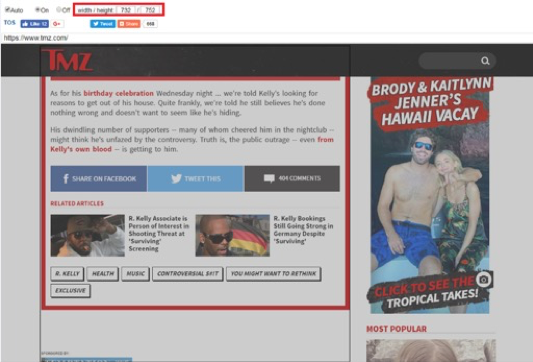
Despite a relatively busy interface, TMZ’s home page is easy to read.
HANDPICKED RELATED CONTENT:
Ride the news cycle
Six of the 10 most visited blogs of 2018 base their strategies around publishing timely content relevant to their niche. In the case of TMZ, that means covering breaking celebrity scandals and gossip, while websites like The Verge focus on reporting on cutting-edge technology, science, and culture.
According to Huffington Post founders Jonah Peretti and Paul Berry, the site’s popularity was built on the ability to deliver near-real-time coverage in a variety of areas (sports, entertainment, and politics).
As Business Insider reports, “During all major events, Berry says their traffic surges, because people trust that they’ll have the latest coverage.”
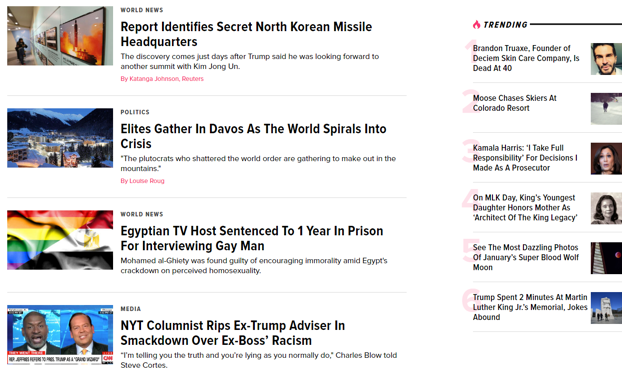
Keep content timely and the clicks will come.
The takeaway is clear – timely content could turn your blog into a regular stop for target audiences.
Timely #content could turn your #blog into a regular stop for target audiences, says @DaveBrown500.CLICK TO TWEETA few words of caution: Be judicious in your attempts to piggyback off the latest trends. There are countless examples on social media of businesses that attempted to leverage a current event to promote their brand without considering the optics of their posts.
If you’re taking on the news cycle, make sure that your content is relevant to the topic and your audience, and that you bring your unique perspective on the situation at hand.
HANDPICKED RELATED CONTENT:
Find a lucrative sub-niche
When it comes to creating a viable online audience, a build-it-and-they-will come mentality doesn’t always translate to profitability. Now, there are a few factors to consider if you want to attract high-quality leads to your website.
First, what is the total market size for your target niche? If you’re aiming at a highly saturated market such as travel or beauty, then you’re going to have a much harder time gaining traction. However, gaining access to even a small portion of the readership in one of these verticals can mean significant traffic. On the other hand, building your blog around an obscure topic might give you a greater shot at market domination.
The best way to balance these two factors is by finding a mass market subject that you can tackle from a unique or granular perspective. Take Business Insider, for example. The company managed to beat more established brands such as Forbes by examining cultural, political, and industry-specific issues through a financial lens.

Offer unique value to dominate your sub-niche.
Effectively categorize and tag your posts
Remember, Google’s search engine crawlers aren’t ranking your blog posts based on style and focus of the content. They’re looking for major indications of what your blog is about. If your posts aren’t arranged in a manner that makes this clear, these bots will have a difficult time accomplishing their objective.
Think about it this way. If you’re running a sports blog that’s primarily about basketball but recently branched out into baseball, then Google will give less importance to any new baseball-related content because it already pegged your website as a basketball resource.
The best way to resolve this issue is with a well-structured taxonomy. The first step in this process is to determine a set of categories that your blog will tackle. Let’s take Vice’s blog as an example. As a brand that’s made its name off hard-hitting original content, Vice has built a diverse array of content over the years.
To make it easier for search engines and, by extension, readers to find relevant writing within this smorgasbord, Vice sorts posts into categories. Some, such as film and fashion, seem obviously pitched toward the general reader, while more niche categories, such as black markets and God squad, are clearly aimed at regular visitors who come for site-specific content.
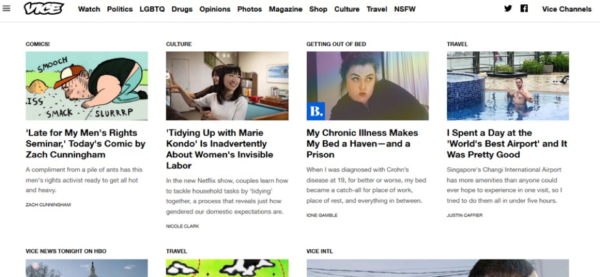
Display a diverse array of categories.
That’s not the end of taxonomy. A post that falls within one classification may touch on more in-depth topics that aren’t communicated through that category. To attract more niche audiences, you need to drill down even further to create highly specific tags that clearly identify the main themes of each blog post.

Use tags relevant and targeted to user intent.
Now, there are a few guidelines to follow:
- Never duplicate the same tag multiple times on the same article.
- Keep your tags short. Take cues from Twitter where the most popular hashtags rarely exceed two words.

- Tags are not keywords. You aren’t optimizing for SEO. Instead, think of user intent and include terms that would be relevant to your reader’s interests.
Integrated content strategies
Sometimes leading the pack isn’t possible. If you’re operating in a market like sports, for example, you’re competing with media behemoths like ESPN and Fox – companies that have endless resources to dedicate to content creation.
When you’re outgunned, you must build a brand that offers something different. Barstool Sports typifies this approach. Though Barstool employs a full team of writers, it has still established a consistent voice that emphasizes person-on-the street opinions on a range of hot-button topics.
The website’s unique take on sports reporting has given rise to a highly devoted following, which consists of younger fans looking for a more informal way to discuss their favorite teams and pop culture in general.
Recognizing that its audience was looking for new ways to interact with the brand, Barstool put some of its more popular writers in front of the microphone. The site’s first podcast, The Pat McAfee Show, drew massive numbers on iTunes before it launched, and that level of engagement continued across Barstool’s newer podcasts.
Today, the company is a multimillion-dollar entity that has a finger in multiple forms of media, including podcasting, online video, and pay-per-view events. The key to success across all these streams of content is Barstool’s retention of the same brash and relatable personality that drew readers to its blog in the first place.
HANDPICKED RELATED CONTENT:
Repurpose content and multiply value
Entrepreneurs like Tim Ferriss have perfected the art of spinning a single piece of content in multiple ways. He often follows up concepts he tackled in blog posts with long-form podcasts and he uses key takeaways from his podcast interviews to create supplementary blog posts that serve as an introduction to interested readers.
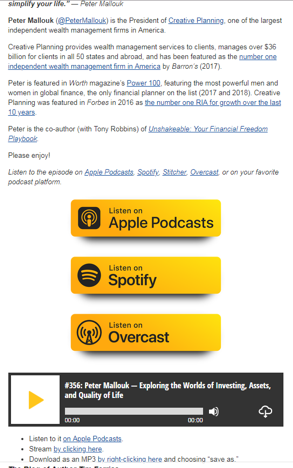
Get maximum dividend from your content like Tim Ferriss does.
These strategies are combined with social media snippets that pull from both articles and podcasts to create tailored content for platforms like Twitter and Facebook.
Grab attention and deliver solutions
In the early part of this decade, blogging platforms like BuzzFeed and Upworthy built massive empires off intriguing and emotionally compelling headlines that drew clicks with alarming consistency. These so-called clickbait titles leveraged basic human psychology, promising exclusive value in return for a small investment of effort.
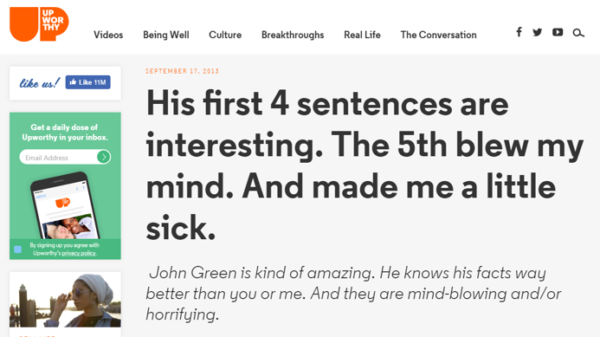
Upworthy CEO Eli Pariser later described this headline as a particular low point in the site’s reporting.
Unfortunately, few of those posts delivered on readers’ expectations. As a result, search engines and social networks adjusted their algorithms to reward more personalized content, thus devaluing these gimmicky headlines. While clickbait is still prevalent across the internet, most readers are now smart enough to steer clear of it.
However, some of today’s most successful blogs combine the compulsive quality of clickbait with valuable solutions that address their readers’ concerns.

Follow big promises with exceptional content.
Where other bloggers would use the promise of seven-figure annual incomes to lure readers into a marketing funnel for a new training program or course, Making Sense of Cents’ Michelle Schroeder-Gardner backs up her headlines with detailed reports explaining how she earns her revenue.
The same principle applies across the website. We examined a representative sample of posts from the Making Sense of Cents home page and found that the average blog post clocks in at a hefty 2,300 words. Whether Michelle is writing content herself or handing things over to a guest blogger, she makes every effort to be as exhaustive as possible and readers respond accordingly.
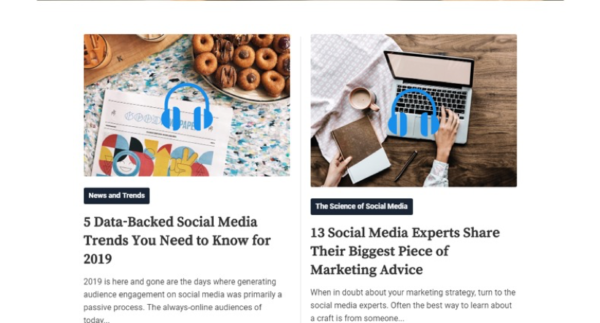
The internet (and your audience) loves fresh statistics.
Buffer’s social blog employs a similar formula in the digital marketing domain. These blog posts take the tried-and-tested listicle headline format and combine it with unique insights drawn from in-house research and acknowledged industry experts. Readers who click on these posts do not walk away disappointed.
Follow @Buffer’s lead – use listicle headlines w/ unique insights from in-house research & experts. @DaveBrown500CLICK TO TWEETHANDPICKED RELATED CONTENT:
Leverage the comments
Your comments section provides a vital pathway through which you can create sustained engagement on a blog post. By eliciting and responding to feedback from your readers you show them that you are personally invested in the topic at hand, which creates authenticity around your brand.
Visible user interest also creates social proof around your writing and encourages other readers to chime in and interact. After all, there’s no smoke without a fire.
The comments section can also provide a key avenue for user research. The insights you gain from readers will help guide future content in a more targeted manner.
Ryan Biddulph is a blogger who leverages the potential of the comments section to the fullest. Known as the comment king, Ryan built his popular Blogging From Paradise platform off the back of consistent interactions on several blogs.
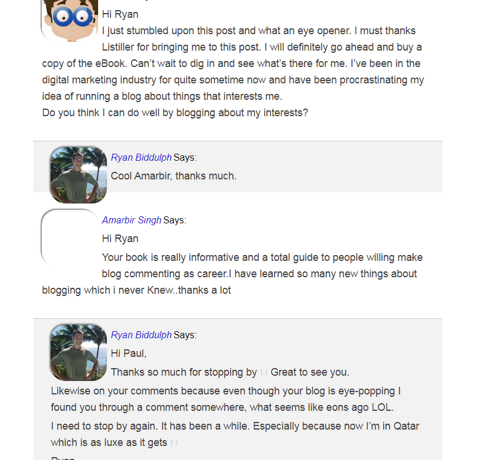
Become the comment king in action.
Build a brand around your content
At the end of the day, even the most well-researched, carefully crafted content may not necessarily shift the needle on your monthly traffic volumes if it isn’t packaged and positioned correctly.
Before you sit down to write a new blog post, you need to consider a couple of factors:
- Who are the ideal readers for this piece? What are their core values, pain points, political opinions, interests, and aspirations?
- What differentiates your content from the competition?
- How does the focus of the blog post tie in with your overall vision and objectives for your business/career?
- Is this post consistent with the theme of other content you’ve published?
The answers to these questions should form the basis for your content strategy moving forward. They will dictate the specific sub-niches that you target, the type of language you utilize, and even the overall design of your blog.
Most importantly, if you succeed in building an authentic and relatable brand through all these elements then you can essentially mark yourself as the authority in your chosen space. Of course, once you’ve gained that level of influence you can leverage it to sell related products and services, or to diversify into new businesses.
Learn from the lifestyle bloggers
Lifestyle bloggers are particularly adept at creating this kind of authenticity. Barefoot Blonde creator Amber Fillerup Clark transitioned from posting smartphone selfies and casual musings on college life to a seven-figure blogging business through intelligent brand-building.
First, she established a pattern of accompanying each new post with glossy, original photographs of herself and/or her spouse. The intention was to invite readers into her life and make them invested in her daily triumphs and trials.
Second, she adopted a breezy conversational style for her blog posts that emphasized the personal nature of her blog. Again, this helped to create deeper connections with her readers. The design of her website also serves this philosophy. Although the blog follows modern UX trends by maintaining white space and streamlining visual elements, individual posts tend to adopt a more casual structure. Certain posts will include long passages of text, while others will be neatly ordered into short and snappy listicles.


Amber Fillerup Clark has built a brand that allows her to market her favorite products and share her thoughts with equal ease.
All these elements work together to create an improvisational quality that is extremely appealing to the core audience. This is reflected in the kind of engagement that she manages to get on the blog. A representative sample of posts from the Barefoot Blonde home page reveals an average of 11 comments per post, without any active input from the author herself.
Get more inspiration from the top 50
Here’s a list of all the blogs that made our category-based list:
Health
Entertainment
Lifestyle and hobbies
Financial advice
Sports
Politics
General interest
Science
Business
Marketing
- garyvaynerchuk.com
- copyblogger.com
- SEMrush.com
- moz.com/blog
- blog.hubspot.com
- adweek.com
- blog.bufferapp.com
Tech
Information technology
Gaming
Summing up
In recent years, many digital marketers have complained about the limited reach of blogging when compared to shorter content delivery channels like Facebook and Twitter. What these individuals don’t understand is that blogging doesn’t aim to deliver the instant impact of social media platforms.
At their best, blogs create a real conversation between the writer and the audience, one that encourages consistent engagement, thereby compelling readers to seek other ways to connect with you. Whether that’s through online profiles or via related products and services depends on how you’ve built your marketing funnel.
By learning from the tried-and-tested models of true innovators in this space, you too can make this long-established channel the centerpiece of your content marketing strategy.
Have a top strategy or tactic in content marketing? Enter it in the 2019 Content Marketing Awards today.
Cover image by Joseph Kalinowski/Content Marketing Institute
Author: Dave Brown
I’ve always loved storytelling. What started with impromptu nighttime stories for my kid sister, has led to writing content for businesses across the US. Of course, there are many tales to share from what happened between then and now. Maybe one day, I’ll write one of the American greats. Get in touch with me and my small army of blog writers for any content help you need by visiting ContentDevelopmentPros. Follow Dave on Twitter @DaveBrown500.
Other posts by Dave Brown
HOW-TO GUIDES
Content Marketing 101 beginsPLAN
Build fundamentals of your planAUDIENCE
Understand your core audiencesSTORY
Tell your brand storyCHANNELS
Determine your distribution channelsPROCESS
Manage your team and toolsCONVERSATION
Create your content and listenMEASUREMENT
Prove the effectiveness of your program
- July 1, 2020
- August 31, 2020
- June 22, 2020
- August 6, 2020
- June 16, 2020
- August 10, 2020
- June 25, 2020

























No comments:
Post a Comment